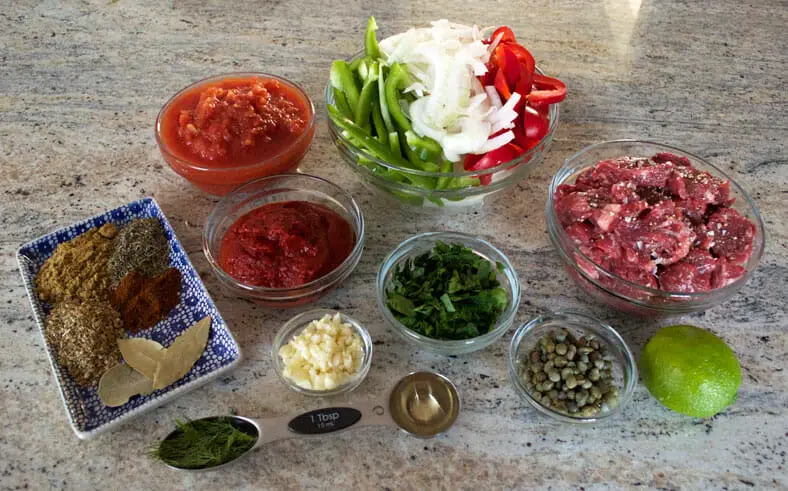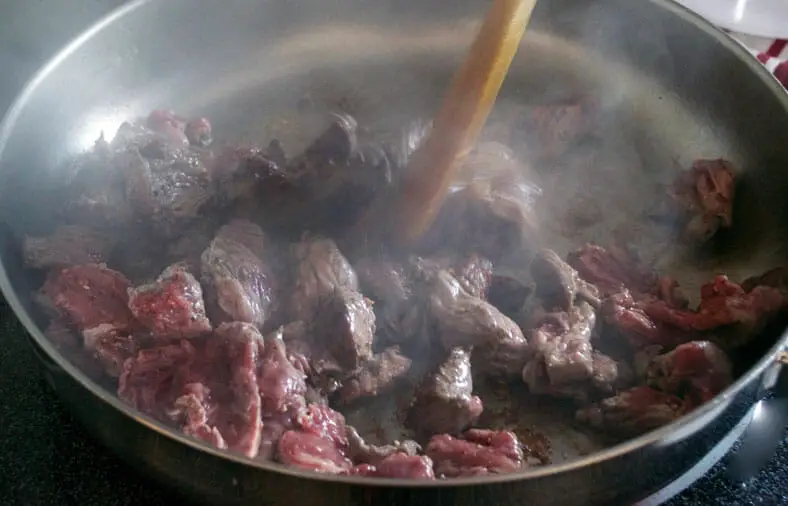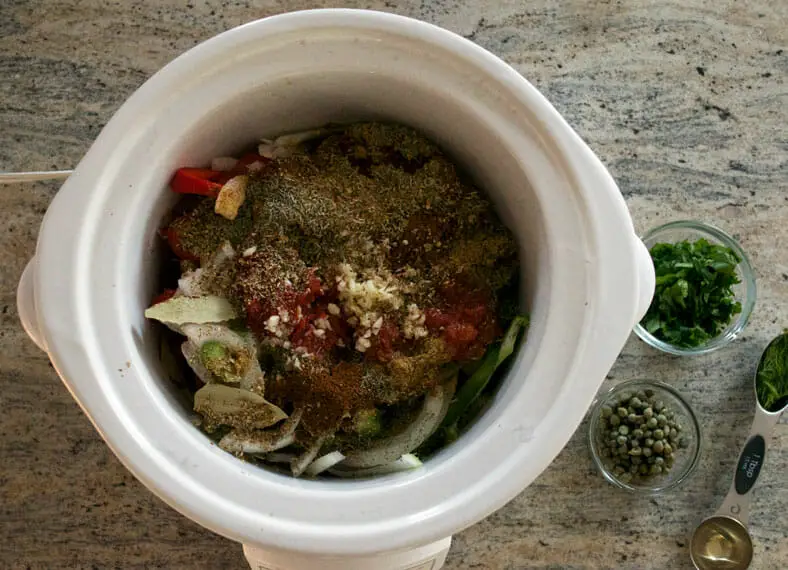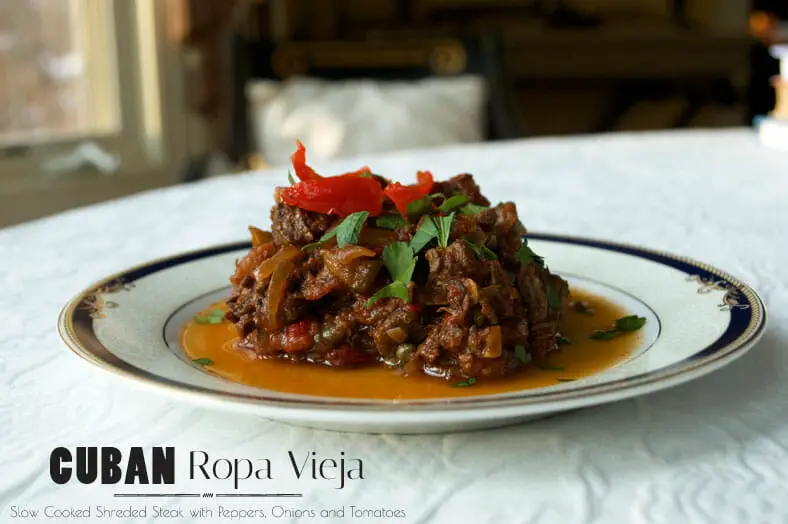We love getting feedback from the Arousing Appetites community. Recently, we were asked to write about a few more meaty recipes, and of course we’re happy to oblige.
Unfortunately for Heather, who has been a pescatarian (vegetarian and fish diet) since 2007, she won’t be privy to enjoy these delicious recipes, but I sure can.
And boy… did I enjoy ropa vieja.

What is Ropa Vieja?
Well, the ropa vieja we’re covering today is the one that’s become a classic dish around Cuba. This particular ropa vieja is recognized as a Cuban national dish, and there certainly seems to be a lot of pride around it. In our research, we came across umpteen Cubans who had added their own unique flair and special tweaks to the baseline ropa vieja recipe.
But the history of ropa vieja actually begins earlier than that. The original ropa vieja originates from the Canary Islands, a set of Spanish islands in the northwest corner of Africa between Spain and Morocco.
The origins of the recipe for ropa vieja and its contemporary Spanish cousin cocido trace back to the Sephardic Jews living in the southern parts of the Iberian peninsula. Since these Sephardi were expelled from Spain rather abruptly and violently in 1492, the roots of this recipe are at least 500+ years old. Because cooking was not allowed on days of the Sabbath, the Sephardic Jews developed recipes and techniques for slow cooking food overnight to be fully ready for eating for the cooking-free Sabbath.
The explanation for the name ropa vieja, which translates directly into English as “old clothes,” has a fun and lighthearted story to it. The legend has it that an old poor man didn’t have the money needed to buy ingredients to feed his family, so he resorted to shredding his clothes to cook. Before cooking, he imparted a prayer and his love into the clothes and was rewarded with a delicious (and edible…) hearty beef stew instead.
From Spain, the ropa vieja recipe eventually made its way to all over the Americas – both in the Caribbean and into South America, as the Spanish explored the New World and established sailing routes across the ocean. And as one of the last seaports before setting sail, much of the rituals and customs in Canarian culture had particular influence in the new lands.
About the Recipe

Ropa vieja is the famous Cuban version to a dish that’s adapted and eaten all around the Spanish speaking world. The Spanish have a slow-cooked stew of beef and chickpeas called cocido. In the Dominican Republic, there’s a recipe for carne ripiada (shredded beef), and the Venezuelans have a carne mechada recipe that is eerily similar to ropa vieja.
Regardless of name, all of these dishes – including the Cuban – start with the same central ingredient. The falda. English speakers can closely refer to the falda as flank steak, although brisket is another type of meat that works well too.
In order to flavor the falda and ensure that it’s extra shreddable for the ropa vieja, most recipes (including our original reference) will pre-sear and brown the meat prior to the simmering portion of the recipe.

With meat seared and ready for slow cooking, next on the docket is the sofrito. Sofrito is an absolute must in almost any Cuban recipe, and it is a mixture of ingredients like tomatoes, onions, garlic, and bell peppers sauteed and braised together with tomato sauce, spices and olive oil. Some versions of sofrito will add a white wine and sherry to the braising liquid as well, but this is more a secondary ingredient to sofrito than primary.
The seared falda and sofrito are combined together in a stockpot or crockpot (we chose the latter) with additional broth, which then cooks together on a low simmer for several hours. During this time, all flavors meld together and the beef cooks slowly to “fall apart status” where it can be easily shredded with as little pressure as that from the back-end of a fork.
Finally, to round out the flavor of dish, there’s a final brine added to the ropa vieja within the last half hour of simmering. The intention here is to give another saline kick to the dish without having to necessarily over-salt. Depending on what ingredients are available, this brine can either come from olive juices, a vinegar, or from citrusy sources as well.
Our Take on the Recipe
We ended up opting to go the route of the crockpot for this particular recipe. Ropa vieja can just as easily be made in a large stockpot and simmered over a low stove heat, and there are big advantages to this stovetop approach as well. The entire recipe will cook faster – needing just 2 hours of simmer instead of 8 for the crockpot – and doesn’t require a special piece of equipment.
Having tested both approaches, though, using the slow-cooking crockpot better achieved the shredded meat “old clothes” look and feel intended for ropa vieja. Also, as Chief Taste Tester for this recipe, I personally preferred the more wholesome melded taste of the slow cooker version myself.

One major change we did – or you could say we didn’t make – is pre-combining the sofrito ingredients together. To make sure the ingredients retained some form after 8 hours of slow cooking, all the sofrito ingredients were added as-is into the crock pot versus the normal sauteeing and braising that would occur first.
Next, compared with our original recipe, we included additional herbs and spices common to other Cuban dishes. Most notably, we added chili powder, dried oregano and thyme, as well as a touch of fresh dill for good measure.
We had come across several recipes adding a red chili pepper or a jalapeno to give extra heat to the ropa vieja, and while we normally openly embrace any addition of heat to a recipe, it was the simpler, milder versions of ropa vieja that actually was more preferable in the end.
For the brine, ours was a combination of white wine vinegar and capers, which cooked together beautifully in the final half hour in the crockpot. By the time the ropa vieja was ready to serve, the capers were soft and mild in their flavor, while the dish had that desired tang around it.
In the end, though, ropa vieja is a delicious and simple recipe – crockpot or no crockpot – that yields a full flavor and delicious, wholesome taste for any dish.
Serve it with black beans or some hearty Cuban rice, and you have a seriously great meal that awaits.
Are you a fan of using the crockpot for your ropa vieja? Comment below!



2 thoughts on “Ropa Vieja: Cuban Shredded Slow Cooked Beef”